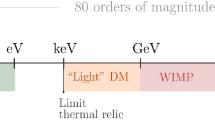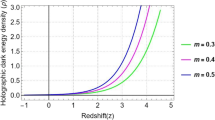Abstract
A cosmological model for the present Universe is analyzed whose constituents are a non-interacting baryonic matter field and interacting dark matter and dark energy fields. The dark energy and dark matter are coupled through their effective barotropic indexes, which are considered as functions of the ratio of their energy densities. Two asymptotically stable cases are investigated for the ratio of the dark energy densities which have their parameters adjusted by considering best fits to Hubble function data. It is shown that the deceleration parameter, the density parameters, and the luminosity distance have the correct behavior which is expected for a viable present scenario of the Universe.
Similar content being viewed by others
References
Riess A.G. et al.: Observational evidence from supernovae for an accelerating universe and a cosmological constant. Astron. J. 116, 1009 (1998)
Riess A.G. et al.: BVRI light curves for 22 Type Ia Supernovae. Astron. J. 117, 707 (1999)
Perlmutter S. et al.: Measurements of omega and lambda from 42 high-redshift supernovae. Astrophys. J. 517, 565 (1999)
Astier P. et al.: The supernova legacy survey: measurement of Ω M , ΩΛ and w from the first year data set. Astron. Astrophys. 447, 31 (2006)
Spergel D.N. et al.: First year Wilkinson microwave anisotropy probe (WMAP) observations: determination of cosmological parameters. Astrophys. J. Suppl. 148, 175 (2003)
Spergel D.N. et al.: Wilkinson microwave anisotropy probe (WMAP) three year results: implications for cosmology. Astrophys. J. Suppl. 170, 377 (2007)
Eisenstein D.J. et al.: Detection of the baryon acoustic peak in the large-scale correlation Function of SDSS Luminous Red Galaxies. Astrophys. J. 633, 560 (2005)
Sahni V., Starobinsky A.A.: The case for a positive cosmological lambda-term. Int. J. Mod. Phys. D 9, 373 (2000)
Sahni V.: Dark matter and dark energy. In: Papantonopoulos, E.(eds) The physics of the early universe. Lecture Notes in Physics, vol. 653, Springer, Berlin (2005)
Carroll S.M.: The Cosmological Constant. Living Rev. Rel. 4, 1 (2001)
Padmanabhan T.: Cosmological constant: the weight of the vacuum. Phys. Rept. 380, 235 (2003)
Peebles P.J.E., Ratra B.: The cosmological constant and dark energy. Rev. Mod. Phys. 75, 559 (2003)
Copeland E.J., Sami M., Tsujikawa S.: Dynamics of dark energy. Int. J. Mod. Phys. D 15, 1753 (2006)
Weinberg S.: The cosmological constant problem. Rev. Mod. Phys. 61, 1 (1989)
Steinhardt P.J.: Critical Problems in Physics. In: Fitch V.L., Marlow D.R., Dementi M.A.E. (eds). Princeton University Press, Princeton (1997)
Chimento L.P., Jakubi A.S., Pavon D.: Enlarged Q-matter cosmology. Phys. Rev. D 62, 063508 (2000)
Chimento L.P., Jakubi A.S., Pavon D., Zimdahl W.: Interacting quintessence solution to the coincidence problem. Phys. Rev. D 67, 083513 (2003)
Binder J.B., Kremer G.M.: Model for a Universe described by a non-minimally coupled scalar field and interacting dark matter. Gen. Relativ. Gravit. 38, 857 (2006)
Tocchini-Valentini D., Amendola L.: Stationary dark energy with a baryon dominated era: solving the coincidence problem with a linear coupling. Phys. Rev. D 65, 063508 (2002)
Farrar G.R., Peebles P.J.E.: Interacting dark matter and dark energy. Astrophys. J. 604, 1 (2004)
Kremer G.M.: Dark energy interacting with neutrinos and dark matter: a phenomenological theory. Gen. Relativ. Gravit. 39, 965–972 (2007)
Huey G., Wandelt B.D.: Interacting quintessence, the coincidence problem and cosmic acceleration. Phys. Rev. D 74, 023519 (2006)
Mangano G., Miele G., Pettorino V.: Coupled quintessence and the coincidence problem. Mod. Phys. Lett. A 18, 831 (2006)
Chimento, L.P., Forte, M.: Unified model of baryonic matter and dark components. Phys. Lett. B [arXiv:0706.4142] [astro-ph]
Cai R.G., Wang A.: Cosmology with interaction between phantom dark energy and dark matter and the coincidence problem. JCAP 0503, 002 (2005)
Amendola L.: Coupled quintessence. Phys. Rev. D 62, 043511 (2000)
Amendola L., Tocchini-Valentini D.: Stationary dark energy: the present Universe as a global attractor. Phys. Rev. D 64, 043509 (2001)
Amendola L., Tocchini-Valentini D.: Baryon bias and structure formation in an accelerating Universe. Phys. Rev. D 66, 043528 (2002)
Amendola L., Quercellini C., Tocchini-Valentini D., Pasqui A.: Constraints on the interaction and self-interaction of dark energy from cosmic microwave background. Astrophys. J. 583, L53 (2003)
Dalal N., Abazajian K., Jenkins E.E., Manohar A.V.: Testing the cosmic coincidence problem and the nature of dark energy. Phys. Rev. Lett. 87, 141302 (2001)
Amendola L., Camargo Campos G., Rosenfeld R.: Consequences of dark matter–dark energy interaction on cosmological parameters derived from SNIa data. Phys. Rev. D 75, 083506 (2007)
Guo Z.K., Ohta N., Tsujikawa S.: Probing the coupling between dark components of the Universe. Phys. Rev. D 76, 023508 (2007)
Boehmer C.G., Caldera-Cabral G., Lazkoz R., Maartens R.: Dynamics of dark energy with a coupling to dark matter. Phys. Rev. D 78, 023505 (2008)
Pavón, D., Wang, B.: Le Châtelier-Braun Principle in Cosmological Physics. Gen. Relativ. Gravit. (2008, in press)
Zimdahl W., Pavon D.: Interacting quintessence. Phys. Lett. B 521, 133 (2001)
Simon J., Verde L., Jimenez R.: Constraints on the redshift dependence of the dark energy potential. Phys. Rev. D 71, 123001 (2005)
Abraham R.G. et al.: The Gemini deep deep survey: I. Introduction to the survey, catalogs and composite spectra. Astron. J. 127, 2455 (2004)
Treu T., Stiavelli M., Moller P., Casertano S., Bertin G.: The properties of field elliptical galaxies at intermediate redshift. II: photometry and spectroscopy of an HST selected sample. Mon. Not. R. Astron. Soc. 326, 21 (2001)
Nolan P.L., Tompkins W.F., Grenier I.A., Michelson P.F.: Variability of EGRET gamma-ray sources. Astrophys. J. 597, 615 (2003)
Press W.H. et al.: Numerical Recipes. Cambridge University Press, Cambridge (1997)
Freedman W.L. et al.: Final results from the Hubble Space Telescope key project to measure the Hubble constant. Astrophys. J. 553, 47 (2001)
Virey J.M. et al.: Determination of the deceleration parameter from supernovae data. Phys. Rev. D 72, 061302(R) (2005)
Riess A.G. et al.: Type Ia Supernova discoveries at z > 1 from the Hubble Space Telescope: evidence for past deceleration and constraints on dark energy evolution. Astrophys. J. 607, 665 (2004)
Riess A.G. et al.: New Hubble Space Telescope discoveries of type Ia supernovae at z > 1: narrowing constraints on the early behavior of dark energy. Astrophys. J. 659, 98 (2007)
Author information
Authors and Affiliations
Corresponding author
Rights and permissions
About this article
Cite this article
Chimento, L.P., Forte, M. & Kremer, G.M. Cosmological model with interactions in the dark sector. Gen Relativ Gravit 41, 1125–1137 (2009). https://doi.org/10.1007/s10714-008-0694-5
Received:
Accepted:
Published:
Issue Date:
DOI: https://doi.org/10.1007/s10714-008-0694-5




